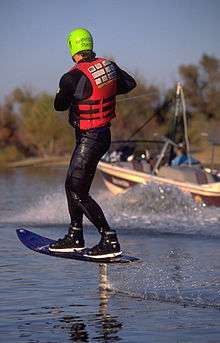Foilboard

A foilboard or hydrofoil board is a surfboard with a hydrofoil that extends below the board into the water. This design causes the board to leave the surface of the water at various speeds.
The first foil board was created to tow behind the boat by surfer Jimmy Soladay in 1993. [1]
Laird Hamilton, a prominent figure in the invention of big wave tow-in surfing, later discovered the foilboard's capability to harness swell energy with the use of a jet ski, pulling the rider into a wave.[2] Mango Carafino, a big wave tow surfing athlete and water sport instructor from the Hawaiian Island of Maui, was one of the early developers of the hydrofoil board design for stand-up hydro foil boarding (kitesurfing) applications. The stand-up design allows the rider to glide with the moving wave. Hydrofoil kiteboards allow the rider to achieve the same result with the use of a kite.[3] The hydrofoil eliminates the effects of choppy or rough conditions. Due to the hydrofoil's underwater characteristics, the rider can angle higher into the wind than on traditional kiteboards which ride on the surface of the water.
As a result of reduced friction, hydrofoils can attain high speeds and lift at lower speeds compared to conventional designs. Foils are used on wind-surfboards through design development from Neil Pryde Maui, inventors of hydrofoil sailing "windsurfing" boards. Using a moderately sized sail, a foil windboard can achieve speeds over 6 knots faster than the apparent wind.
See also
References
- ↑ TonyKlarich (2012). "Stand Up Guys". Adventures in Water Skiing: Part 4, Hydrofoiling. Retrieved May 14, 2012.
- ↑ Scott Bass (2009). "Laird Hamilton: A Surfermag.com exclusive interview". Surfer Magazine. Retrieved December 2, 2010.
- ↑ "Carafino Hydrofoils".
External links
- Miller hydrofoil, a sailing hydrofoil board